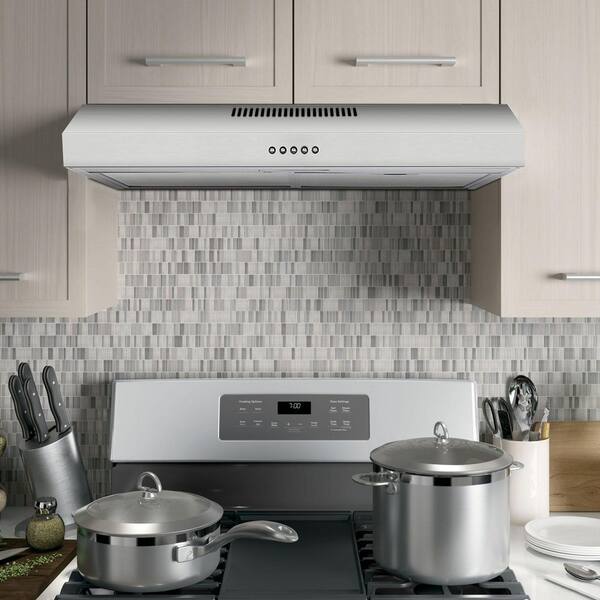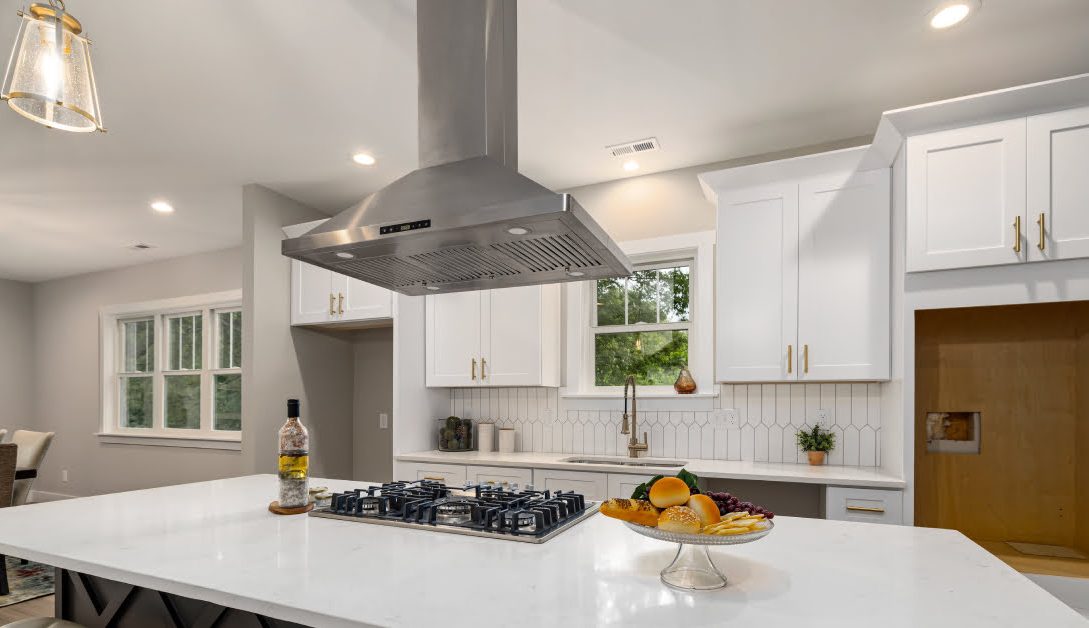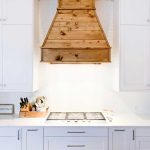A ductless range hood uses a filtration system to remove smoke, steam, and odors from the kitchen. The hood sucks in the polluted air, filtering it through a series of charcoal and mesh filters.
The filtered air is then released back into the kitchen, while the contaminated particles are trapped in the filters and need to be cleaned or replaced regularly. Kitchen ventilation is an essential aspect of maintaining a clean and healthy home.
Cooking produces smoke, steam, and odors that can settle on walls, ceilings, and furniture, leaving a greasy film. A ductless range hood can be a perfect solution for those who do not have the option for venting outside. It is easy to install and provides a cost-effective way to improve indoor air quality. This type of hood is perfect for smaller kitchens and apartments, where ductwork is not feasible. In this article, we will explore how ductless range hoods work, their benefits, and how to choose the best one for your kitchen.

Credit: www.homedepot.com
Understanding The Mechanism Behind Ductless Range Hoods
Explanation Of How Ductless Range Hoods Function
Ductless range hoods are unique in that they don’t vent outside like traditional range hoods. Instead, they use a recirculating fan and filter system to clean the air before redistributing it back into the kitchen. Here’s how it works:
- The range hood fan sucks in smoke, steam, and other cooking byproducts.
- The grease filter traps grease and other solids, while the carbon filter removes odors.
- The fan blows the now-clean air back into the kitchen.
Step-By-Step Guide On How Ductless Range Hoods Work
To better understand how a ductless range hood works, here’s a step-by-step guide:
- Turn on the ductless range hood fan.
- The fan pulls in smoke, steam, and cooking byproducts from your stovetop.
- The grease filter eliminates grease and other solids contained in the smoke.
- The carbon filter removes odors from the air.
- The fan redistributes the cleaned air back into your kitchen.
The Science Behind The Filtration Process In Ductless Range Hoods
The filtration process in a ductless range hood depends on two types of filters: grease filters and carbon filters. Here’s how each filter works:
- Grease filters: These capture and separate solid particles from the air that can come from cooking bacon, grilling burgers, or frying chicken. The solid particles are too large to pass through the filter and get trapped on it.
- Carbon filters: These are designed to be effective at removing odors from cooking that affect the quality of air in your kitchen. The carbon inside the filter is treated with chemicals that combat the odors. The carbon absorbs the smell molecules removing that smell from the cooking area.
By combining the grease and carbon filter mechanism, ductless range hoods are effective in cleaning the air, making cooking less cumbersome and leaving your kitchen smelling fresh.
Components Of Ductless Range Hoods
Ductless range hoods are an essential part of kitchen appliances used to remove smoke, steam, and cooking odors from the air. They work by filtering the kitchen air and releasing purified air back into space, making them an ideal choice for homeowners who have limited space or can’t install a ducted range hood.
In this post, we will look at the components of ductless range hoods and how they work together to perform these functions efficiently.
Overview Of Essential Components In Ductless Range Hoods
Ductless range hoods have four main components that work together to filter the kitchen air – the motor, filter, fan, and duct cover.
Explanation Of The Functioning Of Each Part
Let’s take a closer look at each component’s function to understand how they work:
- Motor: This powers the range hood and is responsible for drawing air up through the filter system. It runs at different speeds, providing variable intensity for suction to match the cooking times.
- Filter: Ductless range hoods have two types of filters, a grease filter, and a carbon filter. The grease filter captures fats and oil droplets, while the carbon filter removes odors caused by cooking or smoking while absorbing chemical fumes.
- Fan: This component is responsible for expelling air out of the range hood and can be adjusted to match the desired external temperature and intensity of cooking.
- Duct cover: This component covers the open area behind the range hood that serves as a vent to release filtered air back into the kitchen.
Comparison Of Working And Significance Of Each Part
While all these components work towards the same goal, each plays a unique role in making ductless range hoods efficient.
The motor powers the range hood, and its strength determines how efficiently the air is drawn up through the filters and out of the duct.
The grease filter captures oily droplets that are a byproduct of cooking, allowing the carbon filter to remain efficient in its odor-absorbing duties.
The carbon filter, on the other hand, is responsible for trapping cooking smells that would otherwise float up to surrounding rooms. Therefore, the efficiency of the range hood depends on the carbon filter’s ability to trap odors and chemicals.
The fan on the ductless range hood should match the desired external temperature and intensity of cooking for efficient air expulsion.
Finally, the duct cover works as a vent, releasing purified air back into the kitchen, making the overall function complete.
Detailed Understanding Of The Importance Of Each Component In Ductless Range Hoods
The significance of each component in ductless range hoods can be attributed to the efficient operation of the range hood as a whole.
The motor’s speed enables you to have variable intensity for suction, matching the cooking time and temperature. The speed should be reduced when cooking low-heat foods and increased when cooking high-heat food.
The grease filter is the first line of defense for trapping any oily droplets that would, over time, reduce the carbon filter’s efficiency. Proper maintenance of the grease filter leads to longer use of the carbon filter.
The carbon filter is the air purifier that traps unwanted smells, chemicals, and other harmful substances. Without the carbon filter, the kitchen will have a foul, rancid smell that can cause health problems.
The fan expels air out of the range hood and duct, back into the kitchen, purifying the kitchen from fumes, steam, and cooking odors.
The duct cover provides a vent for purified air to flow back into the kitchen, thereby keeping it odor-free.
Understanding the components of ductless range hoods is crucial to ensure their efficient operation. Knowing how each part contributes to the range hood’s overall performance can help homeowners make any necessary repairs and replacements to ensure their ductless range hoods operate effectively.
Advantages And Disadvantages Of Ductless Range Hoods
Overview Of Benefits Of Using Ductless Range Hoods
Ductless range hoods, also known as recirculating or non-vented hoods, are designed to purify the air in the kitchen without venting outside. Here are some advantages of using ductless range hoods:
- Ductless range hoods are easy to install and do not require any ductwork, making them a good option for homes without ducting systems.
- They are affordable compared to their ducted counterparts, as they don’t require professional installation or specialized equipment.
- Ductless range hoods come in a variety of stylish designs, making them an attractive addition to any kitchen.
Explanation Of How Using Ductless Range Hoods Can Improve Kitchen Hygiene
Ductless range hoods function by pulling grease, smoke, and other particles from the air before circulating it back into the kitchen. This helps to improve kitchen hygiene in several ways:
- It reduces the buildup of grease on surfaces, which can lead to bacterial growth and fire hazards.
- It eliminates smoke and cooking odors, making the kitchen a more pleasant environment for cooking and dining.
- It promotes air circulation, preventing stagnant air and mold growth in the kitchen.
Comparison Of Ductless Range Hoods With Ducted Range Hoods
Ducted range hoods use ducts to vent outside the kitchen, while ductless range hoods filter and recirculate air. Here is a comparison of the two types of range hoods:
- Ductless range hoods are less effective at removing smoke and odors compared to ducted range hoods, which vent them outside.
- Ductless range hoods require regular cleaning and replacement of their filters to maintain their effectiveness, while ducted range hoods only need occasional cleaning of their ducts.
- Ducted range hoods are more expensive to install and may require modifications to the kitchen structure, while ductless range hoods are easy to install and more affordable.
Discussion Of The Disadvantages And Limitations Of Using Ductless Range Hoods
While ductless range hoods have several advantages, there are also some limitations and disadvantages to consider:
- Ductless range hoods are less effective at removing pollutants from the air compared to ducted range hoods, which vent them outside.
- They require regular maintenance and filter replacement to maintain effectiveness. Failure to clean regularly can lead to reduced suction and poor air filtration, which can lead to a buildup of grease and odors in the kitchen.
- Ductless range hoods are not suitable for kitchens with high heat or grease production, as they may not be able to handle the high volume of pollutants in the air. In such cases, ducted range hoods are more effective.
- They may make noise during operation, as the fan may need to run at high speeds to maintain adequate air purification.
Maintenance And Care Of Ductless Range Hoods
Explanation Of How To Care For And Maintain Ductless Range Hoods
Taking care of your ductless range hood is an important aspect of keeping it functional for a long time. Here are some key points to keep in mind:
- Always turn off the fan before cleaning since cleaning while it’s on could cause damage to the motor.
- Clean the exterior with a non-abrasive cleaner to avoid scratches and damage.
- Check and replace the charcoal filter periodically, usually once every three to four months.
- Make sure to remove any grease buildup using a damp cloth or by washing removable parts in warm soapy water.�
Step-By-Step Guide On How To Clean Ductless Range Hoods
The cleaning process of a ductless range hood is relatively simple, here is a brief step-by-step guide:
- Turn off the fan and unplug the ductless range hood.
- Remove the filter and wash it in warm soapy water or replace it if it’s beyond cleaning.
- Remove the fan blades and clean accumulated dirt and grease with a damp cloth.
- Wipe down the exterior of the range hood with a non-abrasive cleaner to avoid scratches and damage.
- Finally, dry all the components and put them back into place.
Tips On How To Get The Most Out Of Your Ductless Range Hood
Getting the most out of your ductless range hood means keeping up with maintenance and using it properly. Here are a few tips to keep in mind:
- Clean your ductless range hood regularly to avoid the buildup of grease and dirt.
- Replace the charcoal filter routinely to maintain optimal airflow and odor filtration.
- Cook with proper ventilation by using a fan at the right speed and allowing it to run for a few minutes after cooking is finished.
- Make sure the ductless range hood is installed at the recommended height and distance from the cooktop to maximize efficiency.
- Replace the ductless range hood if it is damaged or beyond repair.
Remember that taking care of your ductless range hood will ensure maximum performance and extend its lifespan. By following the guide and tips, you can enjoy a cleaner, safer, and more comfortable cooking experience.
Frequently Asked Questions Of How Does A Ductless Range Hood Work
How Does A Ductless Range Hood Work?
A ductless range hood filters air through a charcoal or carbon filter, then recirculates the clean air back into your kitchen. The filter removes odors, smoke, and other airborne kitchen pollutants.
Can A Ductless Range Hood Be As Effective As A Ducted One?
Although ducted range hoods are typically more effective, recent advancements in technology mean that high-quality ductless range hoods are nearly as effective as their ducted counterparts.
How Often Do I Need To Clean My Ductless Range Hood Filter?
Cleaning frequency depends on how often you use the range hood. Check the manufacturer’s instructions, but as a general rule, it’s a good idea to clean the filter every three to six months.
Is It Easy To Install A Ductless Range Hood?
Ductless range hoods are easier to install than ducted hoods because they don’t require a vent to the outside. However, you still need a power source and a sturdy surface to mount the hood.
Do Ductless Range Hoods Make A Lot Of Noise?
Most ductless range hoods make some noise, but high-quality models have noise-reducing features. Look for range hoods with low sones ratings and multiple fan speeds to reduce noise.
Conclusion
To sum up, a ductless range hood is an efficient and effective kitchen appliance that provides necessary protection against harmful pollutants and unpleasant odors. The filter mechanism ensures that air is recycled and circulated back into the room, making it a practical choice for small spaces.
With technological advancements, ductless range hoods are becoming more powerful and customizable, making them a viable alternative to traditional vented range hoods. However, it is important to keep in mind that ductless range hoods still require regular maintenance and cleaning to ensure optimal functioning.
Overall, investing in a ductless range hood is a smart choice for anyone looking to improve kitchen air quality and create a more comfortable and pleasant cooking experience. Harnessing the power of technology and modern design, ductless range hoods are a clear winner for any kitchen remodel or upgrade project.

Freda is a passionate foodie and kitchen gadget enthusiast. With over 10 years of experience in the culinary industry, Freda brings her expertise in testing and reviewing kitchen gadgets.





